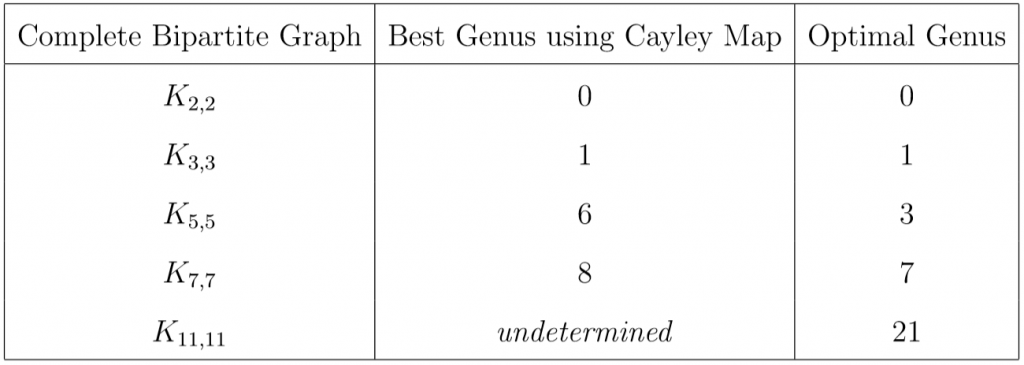Our ability to replicate the optimal genera when embedding complete bipartite graphs onto orientable surfaces varied (See Table Below). Though with ![]() and
and ![]() we were able to obtain optimal genera 0 and 1, respectively, we found that it was impossible to obtain an optimal graph embedding for
we were able to obtain optimal genera 0 and 1, respectively, we found that it was impossible to obtain an optimal graph embedding for ![]() and
and ![]() using Cayley Maps. The smallest orientable surface
using Cayley Maps. The smallest orientable surface ![]() can embed using this method is a six-holed torus, and
can embed using this method is a six-holed torus, and ![]() can embed, at best, an
can embed, at best, an
eight-holed torus. This is likely due to ![]() and
and ![]() being larger, and therefore more complex, than
being larger, and therefore more complex, than ![]() and
and ![]() . As shown in the table below we have yet to determine the minimum genus obtainable using a Cayley Map for
. As shown in the table below we have yet to determine the minimum genus obtainable using a Cayley Map for ![]() . Because
. Because ![]() is much larger than the other complete bipartite graphs discussed, there are more possible face size combinations to rule out, and, as demonstrated in Theorem 7, doing so can be a lengthy process.
is much larger than the other complete bipartite graphs discussed, there are more possible face size combinations to rule out, and, as demonstrated in Theorem 7, doing so can be a lengthy process.
Though using Cayley Maps as a way to embed complete bipartite graphs may not produce the best genera, ![]() ‘s Cayley Map genus was only three higher than optimal, and
‘s Cayley Map genus was only three higher than optimal, and ![]() ‘s was only one higher. Therefore, this method can still be useful if simplicity is a greater priority than genus optimality.
‘s was only one higher. Therefore, this method can still be useful if simplicity is a greater priority than genus optimality.
